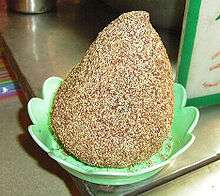Ficus pumila
| Creeping fig | |
|---|---|
.jpg) | |
| F. pumila foliage | |
| Scientific classification | |
| Kingdom: | Plantae |
| (unranked): | Angiosperms |
| (unranked): | Eudicots |
| (unranked): | Rosids |
| Order: | Rosales |
| Family: | Moraceae |
| Genus: | Ficus |
| Species: | F. pumila |
| Binomial name | |
| Ficus pumila | |
| Synonyms[1] | |
|
List
| |
Ficus pumila (creeping fig or climbing fig) is a species of flowering plant in the mulberry family, native to East Asia (China, Japan, Vietnam)[2] and naturalized in parts of the southeastern and south-central United States.[3][4] It is also found in cultivation as a houseplant. The etymology of the species name corresponds to the Latin word pumilus meaning dwarf,[5] and refers to the very small leaves of the plant.
Ficus pumila is a woody evergreen vine, growing to 2.5–4 m (8 ft 2 in–13 ft 1 in). The juvenile foliage is much smaller and thinner than mature leaves produced as the plant ages. This plant requires the fig wasp Blastophaga pumilae for pollination, and is fed upon by larvae of the butterfly Marpesia petreus.
Cultivation
As the common name, "creeping fig" indicates, the plant has a creeping/vining habit and is often used in gardens and landscapes where it covers the ground and climbs up trees and walls. It is hardy down to 1 °C (34 °F) and does not tolerate frost. Therefore in temperate regions is often seen as a houseplant. It is fast-growing and requires little in the way of care. It has gained the Royal Horticultural Society's Award of Garden Merit.[6][7]
It can become invasive and cover structures and landscape features if not maintained and its growth contained. When climbing buildings or wooden structures, the woody tendrils can cling or root in, and damage structures and/or their surface finishes.
Varieties and cultivars
- Ficus pumila var. awkeotsang — awkeotsang creeping fig
- Ficus pumila var. quercifolia — oak leaf creeping fig
- Ficus pumila 'Curly' — curly creeping fig; crinkled leaf form
- Ficus pumila 'Variegata' and Ficus pumila 'Snowflake' — variegated creeping fig; variegated foliage
Cuisine
The fruit of Ficus pumila var. awkeotsang is used in cuisine. In Taiwan, its fruit is turned inside out and dried. The seeds are scraped off and a gel is extracted from their surface with water and allowed to set and form a jelly known in Taiwan as aiyu jelly (or aiyuzi 愛玉子) and in Singapore as ice jelly (文頭雪).
Gallery
- Growing on the Warren Wilson Beach House, in Venice, California
_(20665373299)%2C_Ficus_pumila.jpg) Nature printed leaves, showing their shape and venation
Nature printed leaves, showing their shape and venation.jpg) Fruits
Fruits Dried, inside out fruit of F. pumila var. awkeotsang, ready for use
Dried, inside out fruit of F. pumila var. awkeotsang, ready for use
References
- ↑ The Plant List, Ficus pumila L.
- ↑ Flora of China, Ficus pumila Linnaeus, 1753. 薜荔 bi li
- ↑ Flora of North America, Ficus pumila Linnaeus, 1753. Climbing fig
- ↑ Biota of North America Program 2014 county distribution map
- ↑ Gaffiot, Félix (1934). Dictionnaire illustré Latin-Français (in French). Paris: Librairie Hachette. p. 1278. Retrieved 23 October 2016.
- ↑ "Ficus pumila AGM". Royal Horticultural Society. Retrieved 27 July 2013.
- ↑ "AGM Plants - Ornamental" (PDF). Royal Horticultural Society. July 2017. p. 39. Retrieved 27 February 2018.
External links
| Wikimedia Commons has media related to Ficus pumila. |